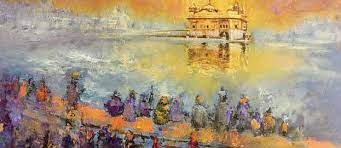What do you know about Sikhi: Sikh is the name given to the religious practice that was established in the Punjab region of South Asia more than five hundred years ago. This makes the Sikh tradition a relatively recent religious practice. As a result of the fact that there are more than 25 million Sikhs on this planet, Sikhism is currently the fifth-largest religion in the world.
Who Founded Sikhism?
Sikhi, also known as Sikhism, is a monotheistic religion that originated in the Punjab region of India in the 15th century. It was founded by Guru Nanak Dev Ji and is based on his teachings, as well as the teachings of nine subsequent Gurus. Sikhs believe in one supreme God and the teachings of the Gurus, which are recorded in the holy scripture Guru Granth Sahib.
Sikhism Beliefs And Practices
Sikhi places a strong emphasis on the principles of equality, social justice, and service to others. Sikhs are expected to live their lives according to the principles of Sangat (community), seva (selfless service), and Simran (remembrance of God).
Sikhs follow the teachings of the Gurus and the Guru Granth Sahib, which provide guidance on how to live a moral and ethical life. The Gurus also taught that all individuals, regardless of their background or social status, are equal in the eyes of God.
Sikhi has a strong tradition of devotion and service, and many Sikhs engage in seva (selfless service) to help those in need. This can take many forms, such as volunteering at a soup kitchen or working to combat social injustices.
Sikhi has a significant presence in India and is also practiced by communities around the world. There are an estimated 27 million Sikhs worldwide, with the largest populations in India and Punjab.
What Do You Know About Sikhi beliefs

- Sikhi is a monotheistic religion that originated in the Punjab region of India in the 15th century.
- It was founded by Guru Nanak Dev Ji and is based on his teachings, as well as the teachings of nine subsequent Gurus.
- Sikhs believe in one supreme God and the teachings of the Gurus, which are recorded in the holy scripture Guru Granth Sahib.
- Sikhi places a strong emphasis on the principles of equality, social justice, and service to others.
- Sikhs are expected to live their lives according to the principles of Sangat (community), seva (selfless service), and Simran (remembrance of God).
- Sikhi has a strong tradition of devotion and service, and many Sikhs engage in seva (selfless service) to help those in need.
- Sikhi has a significant presence in India and is also practiced by communities around the world. There are an estimated 27 million Sikhs worldwide, with the largest populations in India and Punjab.
Sahibzada Fateh Singh Ji
On October 24, 1699, Sahibzada Fateh Singh Ji was born in Anandpur Sahib, Punjab, India. He was Guru Gobind Singh Ji and Mata Jito Ji’s youngest child. Sahibzada Ajit Singh Ji and Sahibzada Jujhar Singh Ji were his older brothers.
When his father, Guru Gobind Singh Ji, departed for his heavenly home, Sahibzada Fateh Singh Ji was just two years old. After that, his mother, Mata Jito Ji, raised him. The children of Mata Jito Ji were raised with a love of Sikhi.
Sahibzada Fateh Singh Ji was a young man of great bravery and valor. He was a great horseman and loved horses a lot. He was also an expert in archery.
He took part in the Battle of Chamkaur against the Mughals when he was only eleven years old. He heroically battled with his siblings, and the Sikhs revered him for it.
The Sahibzadas were taken prisoner by the Mughals and transported to Delhi after the Battle of Chamkaur. They were imprisoned and subjected to regular abuse.
Sahibzada Fateh Singh Ji and his brothers maintained their Sikhi faith in the face of torture. At the age of barely six years old, they were eventually killed on November 13, 1705, for their refusal to become Muslims.
The Sikhs were motivated to fight against the Mughals’ oppression by the Sahibzadas’ sacrifice. The Sikhs still honor their sacrifice today.
https://www.youtube.com/live/NGBiy_qt-Sk?feature=share
One of the sad moments in Sikh history is the martyrdom of Sahibzada Fateh Singh Ji. The Mughal Emperor Aurangzeb had two of Guru Gobind Singh Ji’s young sons, Sahibzada Fateh Singh Ji and Sahibzada Zorawar Singh Ji, bricked alive on November 24th, 1704, at the age of 6 and 9 respectively.
Aurangzeb did this terrible thing to get back at Guru Gobind Singh Ji for getting away from the Gwalior Fort jail. The Mughal army seized the Guru’s two younger sons, who were then taken before the Emperor and ordered to become Muslims.
Aurangzeb ordered the lads to be bricked up alive in a wall when they refused. Even in the face of death, the two Sahibzadas maintained their faith, and their martyrdom is regarded as one of the most valiant deeds in Sikh history.
Read more: Youngest Martyr in History, Sahibzada Fateh Singh Ji, Who is Sahibzada Fateh Singh Ji, Google more searching, Sahibzada Fateh Singh Ji Youngest Martyr In History
